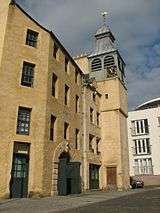North Leith Parish Church

North Leith Parish Church is a congregation of the Church of Scotland, within the Presbytery of Edinburgh. It is serves part of Leith, formerly an independent burgh and since 1920 a part of the city of Edinburgh, Scotland.
Building
The current building in Madeira Street (at the junction with Prince Regent Street), Leith, was designed by the architect William Burn and was completed in 1816. It has a notable neo-classical portico (with four large Ionic columns), above which is a clock tower surmounted by a slender spire. A pipe organ (by Wadsworth of Manchester) was added in 1880. The building was damaged by bombing during World War II (in 1941), but was repaired by 1950. It is a category A listed building.[1]
William Burn was also responsible for several other notable buildings in Edinburgh, including the Edinburgh Academy and John Watson's College (now the Scottish National Gallery of Modern Art).
History

Its origins date back to 1128, when King David I of Scotland granted lands for the construction of Holyrood Abbey. In 1493 Robert Bellenden, Abbot of Holyrood, built St Ninian's Chapel on the north-west bank of the Water of Leith, on lands owned by the Abbey.[2] The small chapel was subsequently rebuilt after the Reformation. The replacement church opened in 1586, and later became the parish church of North Leith, which was created a quoad omnia parish, i.e. a civil and sacred parish, by a resolution of the Parliament of Scotland in 1606. A Dutch-style tower was added in 1675. The discovery of rot in this building in the 18th century led to extensive renovation and the construction of galleries within the building, but the church remained too small for the congregation, leading to its replacement by the current building in 1816 (then in fields just outside the built-up part of Leith). The Dutch-style tower of the old church still stands, although it was later incorporated into a mill.[2] In the old churchyard of St.Ninians stands the altar tomb of Thomas Gladstones (1732 - 1809), a prosperous Leith merchant, and the grandfather of the famous Prime Minister William Ewart Gladstone. Thomas Gladstones was a church elder for the 'Hill' district of Leith for over 40 years.[3]
North Leith Parish Church united with Bonnington Church in 1968, creating Leith North & Bonnington Church (using the Madeira Street building). In 1982, Leith North & Bonnington Church further united with Leith St Ninian's Ferry Road Church, creating the current congregation with the historic name North Leith Parish Church.
Parish
The parish largely consists of the north-west part of Leith, including the Fort housing scheme, Leith Docks, including the Ocean Terminal shopping centre, the Royal Yacht Britannia and the Scottish Government offices at Victoria Quay.
Ministry
A greatly loved cleric, Dr. Johnston, was minister of St.Ninians from 1765 until 1824, some 59 years.[4]
Recent former ministers include:[5]
- Reverend Douglas Clarke (1968–1979) - originally inducted to Leith Bonnington Church in 1965, becoming minister of the united Leith North & Bonnington Church in 1968
- Reverend William G. Neill (1980–1986) - originally inducted to Leith North & Bonnington in 1980, moving to St Andrew's Church, Ayr, in 1986
- Reverend Alastair G. C. McGregor QC BD (1987–2002)
- Reverend Dr Kenneth S. Baird (2003–2009).[6]
- Reverend David H. Logan was minister at St Ninian's Ferry Road Church from 1965 until his retirement in 1982, at which point the congregation united with Leith North & Bonnington.
The current minister (since March 2011) is the Reverend Alexander McAspurren, who was previously minister of one of the two Church of Scotland congregations in Corby, Northamptonshire.[6]
See also
References
- ↑ "North Leith Parish Church: Listed building report". Historic Scotland.
- 1 2 "3-9 Quayside Street, incorporating former Manse, remains of St Ninian's Church, tenement, granary and mill: Listed building report". Historic Scotland.
- ↑ Russell, John, The Story of Leith, Edinburgh, 1922, p.177.
- ↑ Russell, p.177.
- ↑ Fasti Ecclesiæ Scoticanæ (volume XI), T & T Clark, Edinburgh, 2000, page 11. ISBN 0-567-08750-6
- 1 2 Church of Scotland Yearbook 2010-2011 edition, ISBN 978-0-86153-610-8
- Russell, John (1922). "XIV. Our Parish Churches: North Leith". The Story of Leith. Edinburgh: Thomas Nelson & Sons.
External links
Coordinates: 55°58′33″N 3°10′59″W / 55.97583°N 3.18306°W